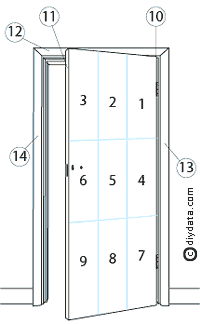Painting flush wooden doors
Before painting wooden flush doors, they need to be prepared as explained on our "Preparing wooden doors and windows for painting" page.
The following guidelines apply when applying Primer, Undercoat or Topcoat (or a combined paint).
After applying Primer or Undercoat, the surface should be lightly rubbed down using a fine glass paper (at least 240 grade) to remove any dust etc which may have been attracted to the paint - do not rub so hard that the wood grain is exposed.
 Painting
a flush door can seem a massive job as there's such a large area and you want the finish to appear smooth and without joins. The secret to a good finished appearance is to work quickly so that the edges of paint are still wet when the adjacent area is being painted, this will allow the fresh paint to be smoothly blended in by overlapping with a few brush strokes.
Painting
a flush door can seem a massive job as there's such a large area and you want the finish to appear smooth and without joins. The secret to a good finished appearance is to work quickly so that the edges of paint are still wet when the adjacent area is being painted, this will allow the fresh paint to be smoothly blended in by overlapping with a few brush strokes.
Before you begin to paint a flush door, imagine the door face to be divided up into a number of areas, with the areas starting at the top by the hinge - as shown to the right.
Using a fairly large paint brush ( 60 - 75mm (2½ - 3 inches)), start by painting the first area on the outside of the door - first using vertical brush strokes, then (without reloading the brush) spread the paint using horizontal strokes, and finish off with light, upward strokes.
When painting an edge area (i.e. 1,3,4,6,7,9 on the diagram), allow the paint brush to turn the corner and lightly cover the edge of the door. Do not paint the top of the door unless it opens outwards so that it can be seen from a stairwell.
Complete the other areas on the first side of the door in a similar manner making sure that you brush onto previously coated areas to hide the join. It is important to be consistent with the amount of paint applied and with the direction of the finishing brush stokes.
Having completed the outside of the door, paint the inside of the door in a similar manner.
Then, using a small brush (25mm (1 inch)), carefully paint the edges of the door, making sure that paint does not 'turn the corner' onto the completed sides - first paint the hinge edge of the door and then the lock edge.
If the door surround is to be painted at the same time (it is often better to paint the door surround at the same time as the skirting board), start by painting above the door, then at the hinge side and finally the lock side of the door. Use a small brush (25mm (1 inch)), and make the finishing strokes in the direct of the wood grain (i.e. horizontal above the door, vertically for the side pieces).
After the finishing coat of paint has been applied, allow the paint to harden before refitting the door furniture.
